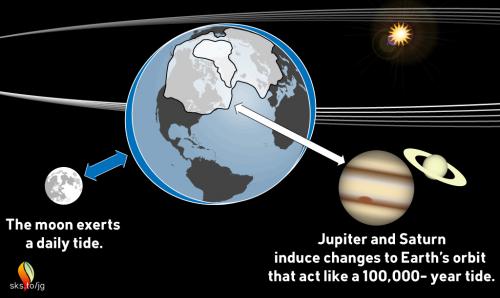
Heavenly bodies regularly cause sea level to change by 0.5 to 120 m (2 to 400 ft).
Human bodies can cause sea level to change by 60 m (200 ft).
You’ve heard it said, “The climate is always changing.” What does that mean?
If someone said, “Mr. Smith is always falling down”, you would assume that Mr. Smith is unstable.
When you hear the phrase “The climate is always changing,” you might think, “I wonder why the climate is so unstable and always changing?” On 100,000-year cycles the global average temperature varies by 5°C, which causes variation in sea level of 120 m (400 ft). That is a lot of sea-level change!
These massive, 120-m glacial tides are caused by heavenly bodies that are hundreds of millions of miles away, tugging on what appears to be a very sensitive environmental system, causing regular, massive changes.
Is it possible that 8,000,000,000 human bodies pushing hard on this same, sensitive environmental system could cause a similar effect?

The tides of Earth include …
The Sun and Moon pull on the oceans, causing bulges in their shape that cause local fluctuations of sea level.
Jupiter and Saturn pull on the Earth, causing bulges and wobbles in Earth’s orbit around the Sun. The influence on Earth’s orbital dynamics caused by Jupiter and Saturn are called Milankovitch cycles, named after a Serbian mathematician, Milutin Milankovitch.2 Because the orbits of planets are very regular, the Milankovitch cycles cause bulges and wobbles in Earth’s orbit that operate over 20,000, 40,000, and 100,000 years. The Milankovitch cycles drive the current ice-age variations.3
Changes in the orbital dynamics caused by Milankovitch cycles affect the distribution of sunlight between the northern and southern hemispheres. When the northern hemisphere receives less sunlight, large glaciers form over North America and Europe. The water used to form the large glaciers comes from the oceans, causing sea level to drop globally by up to 120 m. When the northern hemisphere receives more sunlight the glaciers melt, and sea level rises. The driver of these massive changes is not the orbits of Jupiter and Saturn, but rather feedbacks that are triggered by Jupiter and Saturn.
What are feedbacks? Speak into a microphone connected to an amplifier set on high-gain. Your voice into the microphone triggers a set of feedbacks that repeatedly amplify your original words until a loud squeal comes out of the speakers. Your voice does not cause the squeal, but triggers a set of feedbacks, which in turn cause the squeal.4 A similar process occurs during Milankovitch cycles where a small change in the orbit of the Earth causes a small amount of warming, which triggers feedbacks that eventually lead to large changes in CO2, temperature, and sea level.5
The sequence of events of how Jupiter and Saturn trigger 120-m sea-level change is6
This cycle goes on until the initial, direct effects combined with the feedbacks cause …
• CO2 to change by 100 ppm …
• Which changes global, average temperature by 5°C …
• Which causes sea level to change by 120 m
The direct effect of Jupiter and Saturn is to cause a small increase in temperature, which causes a small increase in CO2 concentration. The feedbacks in Earth’s climate do the rest to cause the 100-ppm CO2 change.
If planets 100’s of millions of miles away can trigger 120-m tides, is there anything that human civilization is doing today that could trigger feedbacks in our sensitive, unstable environment?
By burning fossil fuels we’ve increased CO2 by 140 ppm in 200 years, much more than the initial CO2 pulse during an ice-age cycle.
We live in an era of Earth’s history with very sensitive climate-feedback dynamics.
CO2 is currently increasing about 2.5 ppm/year. This represents a continuous, hard push on the environment.
What kind of feedbacks will we trigger if we keep pushing hard on our sensitive climate system?
1. “Glacial tide” is a term we define for this analogy. It does not refer to direct, tidal influences such as the Sun and the Moon exert on the oceans, but simply refers to the fact that in the same way that the relative orbital dynamics of the Sun, Moon, and the Earth cause periodic sea-level fluctuations, the relative orbital dynamics of Jupiter, Saturn, Sun, and Earth cause periodic sea-level fluctuations. The Sun and Moon cause tidal fluctuations with a period of about 12 hours and simply cause a local redistribution of water up and down a local shoreline, whereas Jupiter and Saturn cause fluctuations with a period of about 20,000, 40,000, and 100,000 years, and which redistribute water between the oceans and the land.
2. https://www.skepticalscience.com/Milankovitch.html
3. Read here for information about ice ages and glaciation cycles.
4. The feedback process is something like: small soundwave (trigger) into microphone -> electrical signal -> amplified electrical signal -> louder sound wave out of speaker and back into microphone -> stronger electrical signal -> amplified stronger electrical signal -> really big sound wave out of speaker and back into microphone -> …
5. https://skepticalscience.com/co2-lags-temperature.htm
6. The dynamics of how the distribution of sunlight between the northern and southern hemispheres causes the complex feedback between CO2 and temperature leading to large-scale glacial formation/retreat is beyond the scope of this analogy. For a summary of the link between Milankovitch cycles and ice sheet growth please read here. The scientific paper referenced in this summary article is available in this Nature article. Also read here for additional information about the effects of positive and negative feedbacks that control glaciation.
Posted by Evan on Thursday, 5 September, 2019
 |
The Skeptical Science website by Skeptical Science is licensed under a Creative Commons Attribution 3.0 Unported License. |